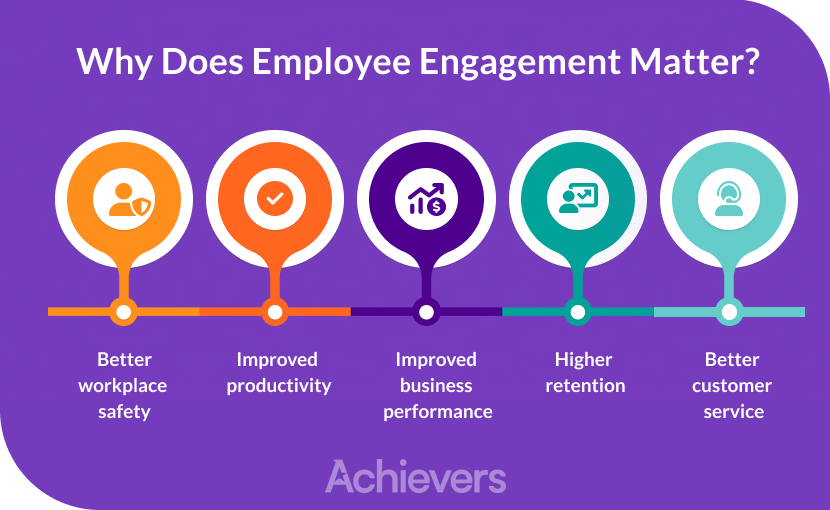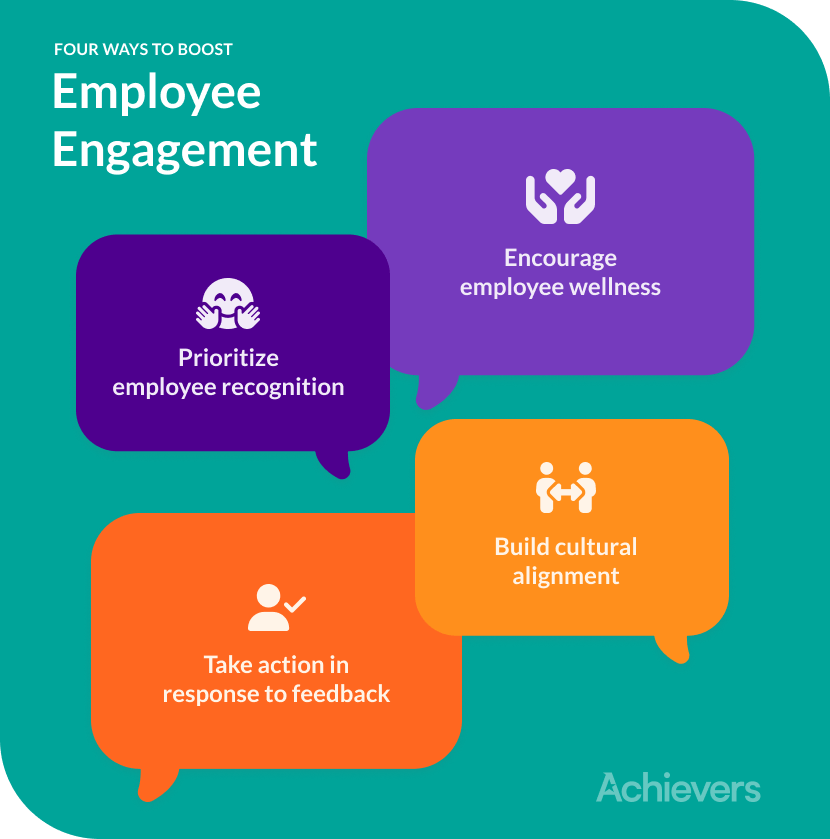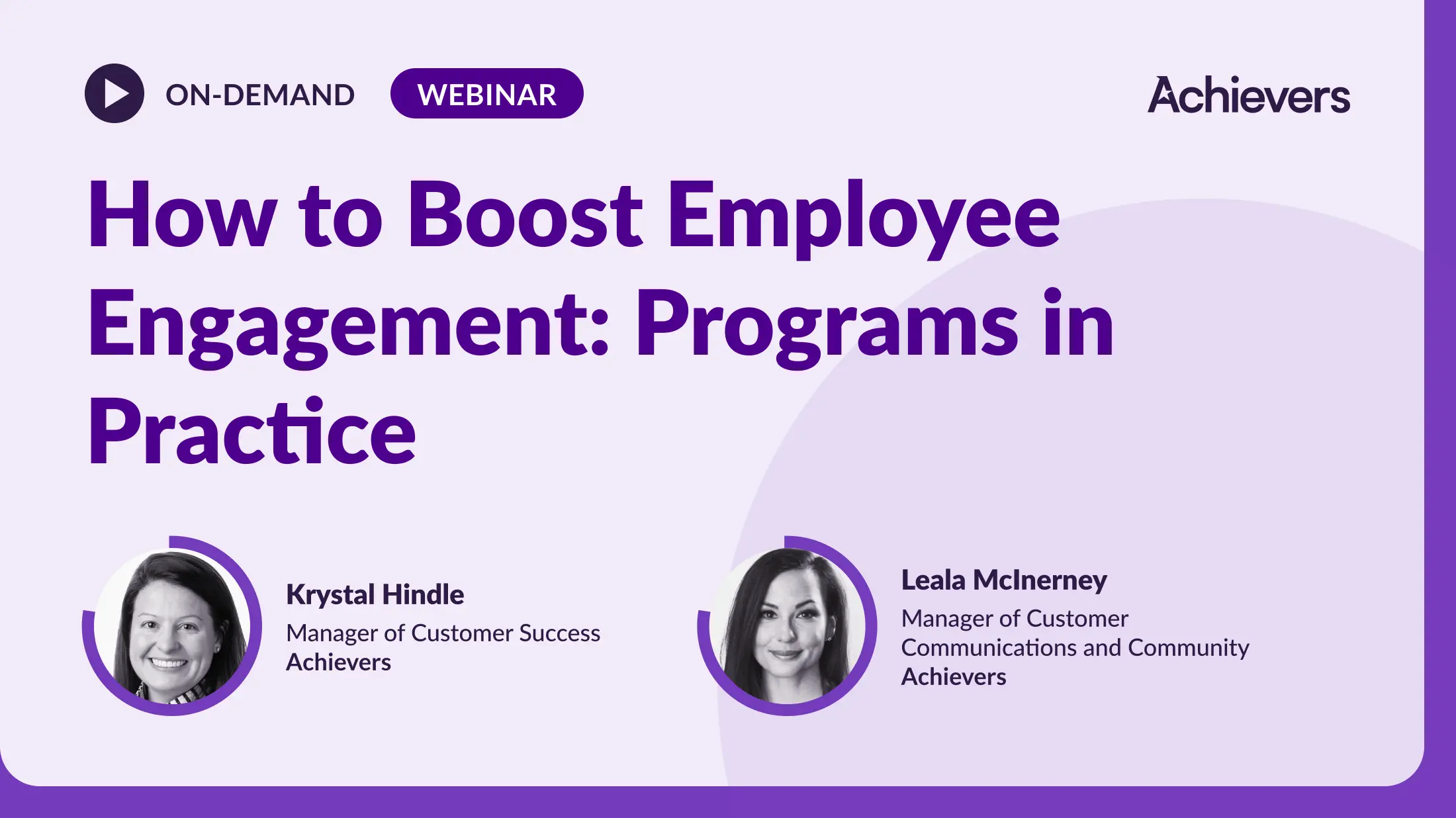Table of contents
Having an employee engagement guide is more than just handy, it’s a tool to help you reduce disengagement — a chronic issue in today’s workplace.
According to the Achievers Workforce Institute’s 2024 Engagement and Retention report, two-thirds of employees have one foot out the door. This sign of low engagement is a serious threat to your bottom line. Low employee engagement cost U.S. companies up to $550 billion a year in lost productivity. On the flip side, Gallup found that highly engaged teams show 23% greater profitability. With so much at stake, it’s no surprise that successful companies put employee engagement at the center of their corporate strategy.
This employee engagement guide has everything you need to make employee engagement a pillar of your organization’s culture, from understanding just what it is to measuring and boosting it. Let’s dive in!
What is the definition of employee engagement?
The definition of employee engagement is a state of a person’s commitment to their work and company. It is a mental and emotional connection that fluctuates and affects everything from retention and organizational performance to your company’s bottom line. Engagement is driven by a wide range of factors, including how frequently employees are recognized and empowered to succeed, and whether organizations solicit and act on employee feedback. To keep track of employee engagement, organizations should use modern tools like pulse surveys and intelligent HR chatbots to establish open, anonymous lines of communication where employees can share honest feedback on these drivers.
What about employee satisfaction?
Employee engagement is about motivation and interest, while employee satisfaction deals with morale. High employee engagement makes employees hard workers and fierce advocates for their company. Employee satisfaction, on the other hand, is more about a personal sense of happiness at work. If an employee is satisfied with their job, it doesn’t necessarily mean they’ll go above and beyond. Of course, engaged employees may have higher satisfaction scores, as feeling motivated makes it much easier to genuinely enjoy what you’re doing.

Why does employee engagement matter?
When employees are aligned with your company’s vision and form bonds with one another, they’re much more likely to be engaged. Employee engagement is a key driver of success in the modern workforce, including:
- Productivity: Organizations with engaged employees outperform their counterparts by 202%
- Retention: Highly engaged workers are 22% more likely to say that they will not job hunt
- Workplace safety: Organizations that rank in the top quarter for engagement had 70% fewer safety incidents
- Better customer service: Research shows that employee engagement is strongly associated with increased customer satisfaction, as do customer stories like that of Discover, which found that sales increased in lockstep with employee engagement.
- Business performance: Highly engaged business units are 21% more profitable. Conversely, disengagement costs the U.S. economy up to $550 billion per year.
Employee engagement statistics
To understand the holistic impact of employee engagement on an organization and its people, you need only look at the statistics:
- Organizations with highly-rated cultures of recognition are 2.5 times more likely to see improved employee engagement.
- 64% of HR leaders say an always-on feedback tool is essential to an engagement listening program, but only 20% have this kind of tool in place.
- 58% of employees wish their company conducted employee engagement surveys more frequently.
- 71% of executives say that employee engagement is an important contributor to organizational success.
- Alignment with company culture is one of the five key factors that lead to employees feeling satisfied and adequately rewarded.
- Managers are responsible for 10 out of 12 actions to engage employees.
12 ways to improve employee engagement
1. Recognition
Employee recognition is the number one driver of engagement. Our recent AWI research study shows that compared to employees who receive recognition quarterly or less, those recognized monthly or more report 2x engagement and productivity. Frequent, specific recognition makes your team members feel welcome and valued. It keeps employees excited about their work by highlighting the positive qualities they bring to the table. And because employees know they’ll be acknowledged for their hard work, they’ll continue to push themselves to perform.
2. Feedback
What does employee feedback really mean? It includes direct communication between employees and managers, of course, but it doesn’t stop there. Employees are more likely to be honest when they can provide feedback anonymously in employee engagement surveys than when discussing things with their manager face-to-face. If you don’t get honest feedback, you won’t know where employee engagement at your organization currently stands or what you can do to improve it. And you have to act on that feedback to show your employees that their voices truly matter.
3. Culture
Employees who resonate with your organizational culture are much more likely to stay dedicated to your company. Cultural alignment influences productivity, retention, and engagement. When employees feel like they fit in, they socialize more with their peers and work collaboratively towards common goals.
4. Team
Who you work with every day plays a huge role in your attitude towards your job. A cooperative environment fosters a sense of belonging among employees. And engaged teammates serve as role models, prompting their peers to work just as hard as they do.
5. Empowerment
Employees want the resources and tools required to get their work done. Without them, employees will get frustrated and eventually lose trust in your organization. And when the going gets tough, unsupported employees are much more likely to give up rather than push through. Employees who are empowered to succeed work more efficiently and know that their organization cares about their performance.
6. Development
Employees want to work on projects that will expand their skill sets. As you might expect, companies with engaged employees provide ample opportunity for growth, both professionally and personally. These opportunities show employees they are appreciated and that their employer is truly invested in their success.
7. Work-life balance
Employee burnout is becoming an unfortunate part of our new normal. Seventy-six percent of American employees experience burnout on the job, while 28% feel burned out “very often” or “always.” While there’s no one quick trick to curing burnout, ensuring work-life balance is truly balanced is as close as it gets. Ensure your employees have enough paid time off (and actually use it), provide flexibility in when and where your team works, and ensure that no one has to take work home with them.
8. Expectations
If employees don’t understand what they’re expected to accomplish, or how they’re supposed to accomplish it, frustration is sure to follow. Even if job expectations are clear, that won’t matter if they’re unrealistic. While employees want a challenge, overwhelming them with task after task will only lead to burnout. Clearly communicate what each role at your organization requires so employees can quickly determine the skills and experience they need to level up, and ensure you capture feedback on how employees feel about those expectations so you can adjust accordingly.
9. Purpose
Finding meaning in work is essential to employee engagement especially in the times of post-pandemic and economic volatility. Employees, then, seek deeper connections and a strong sense of shared purpose at work and companies must feel prepared to deliver. Establish and strengthen company values that your team believes in and watch engagement grow.
10. Role
If an employee doesn’t fit in their current role, they’re likely to feel disengaged. There are many potential reasons for a poor “person-job fit.” Team members may feel out of their depth in their current position, or they might have lost interest in their responsibilities over time. A great match between a team member and their role, on the other hand, leads to better job performance and higher engagement.
11. Manager support
Managers have an enormous influence over employee engagement and are responsible for 10 out of 12 actions to engage employees. A bad managerial relationship saps motivation and drives employees out the door. Managers who serve as coaches rather than bosses can better communicate with their direct reports and build lasting, productive relationships.
12. Leadership and strategy
Confidence in leaders’ ability to navigate arduous circumstances and implement sound strategies is key to building trust with employees. Employees who don’t believe in their organization’s leadership have a hard time convincing themselves to give their all daily. When team members believe that leaders make the right decisions, they’ll do what it takes to make those decisions successful.
Ideas and activities to drive employee engagement
If you’d like to engage your employees, but aren’t sure where to start, here are some engagement ideas and activities to try in your organization:
- Keep feedback channels ‘always on’ with a chatbot
- Take action in response to feedback
- Personalize the employee experience
- Establish a wellness program
- Provide mentorship opportunities
A guide to measuring employee engagement
The first step to improving employee engagement is measuring it. But using a cumbersome tool like an annual employee engagement survey isn’t the answer. By the time the results of these formal, large-scale surveys have been collected and analyzed, it’s months after the fact, far too late to address the issues they reveal. Employees notice when they provide feedback and no action is taken, which only compounds the effects of disengagement.
Instead, track employee engagement in real time with a comprehensive employee engagement software that provides tools like pulse surveys and always-on, AI-powered HR chatbots. A pulse survey is a brief series of questions that track the key drivers and indicators of employee engagement. They’re easy for employees to answer using the device of their choice and can be delivered on a frequent basis to catch any troubling trends or showcase important wins.
How to use pulse surveys to measure employee engagement
Pulse surveys are essentially quick check-ins that provide feedback on employee satisfaction, job role, communication, relationships, work environment, and more. Here’s how to use pulse surveys to measure employee engagement:
- Ensure that you have a good response rate. If less than 10% of employees are responding, it’s an indication that your people aren’t engaged or it’s time to switch up the survey with more relevant questions.
- Evaluate the data and the comments. Use scaled responses to gather data that’s easy to measure. And be sure to review employee comments to open-ended questions to understand what matters most to them.
- Review results with managers and leaders. Discuss how the results align with organizational goals and priorities and compare results with benchmarks to see how engagement scores compare with your competitors.
What does a pulse survey look like? The best use the Likert scale — a simple way to rank a statement on a scale from “strongly disagree” to “strongly agree — to make answering the questions as easy as possible.
Survey questions that help measure employee engagement
Your employee engagement survey should show you what the organization is doing right as well as help you identify and solve problems. To accomplish this, include these top five survey questions:
- How do you feel about work today?
- Would you recommend [organization] to your friends as an employer?
- Are you satisfied with your current compensation and benefits?
- How can we help improve your engagement at work?
- What practices do we need to change?
Beyond pulse surveys, an intelligent HR chatbot prompts employees to answer pulse surveys and proactively asks for other pertinent feedback. Chatbots are available 24/7, so employees reach out anonymously whenever they have something to say. On the back end, employers can collate chatbot and pulse survey data to learn how employees are responding to leadership changes, recognition initiatives, or other drivers of engagement over time.

4 ways to boost employee engagement
Tracking employee engagement is a great first step. Now you’re ready to develop initiatives to boost engagement across your organization. As you do so, incorporate these three strategies to keep employee engagement high.
1. Take action in response to feedback
Gathering engagement data matters, but acting on that data matters more. Failing to take action on employee survey results is worse than failing to survey employees at all. Unfortunately, over half of employees say their organizations make few or no changes in response to their feedback.
This doesn’t have to be the case at your company. Modern employee engagement platforms make it easy for employers to interpret and act on results by highlighting areas of strength and areas for improvement. They then guide managers from insight to action, equipping them for a collaborative meeting with their team to build an action plan everyone can get behind and have a stake in.
2. Prioritize employee recognition
You’d be hard-pressed to find a highly engaged workforce that doesn’t prioritize employee recognition. The more recently someone is recognized, the higher their engagement is likely to be. Recognition doesn’t have to be extravagant or expensive — social recognition can be even more impactful than monetary recognition, when done right. That means following the principles of RISE: show recognition regularly, provide it immediately after the recognized behavior takes place, make it specific to the recipient, and encourage others to recognize their peers as well. These principles also apply to monetary recognition, which can be easily incorporated into your recognition program using a points-based reward system, supported by our employee recognition software.
3. Encourage employee wellness
Wellbeing impacts more than just how employees feel at work; it affects productivity, number of sick days employees take, burnout, and turnover rate. Gallup has found that poor wellbeing and employee burnout cost about $322 billion in turnover and lost productivity globally. Introducing employee wellness programs can lower the chances of burnout and teach employees how to look after themselves.
Putting a wellness program into practice can seem overwhelming, but companies just need to start with the basics. Host webinars or in-person training sessions to educate employees on eating better, meditating, practicing mindfulness, and exercising. Dedicate a portion of your recognition program to reward employees who are progressing towards their wellness goals. Organizations should also remind employees to take their days off, offer flexible working hours, and cheer on employees who pursue creative or philanthropic projects to balance their work.
4. Build cultural alignment
Alignment with an organization’s values is the top predictor of employee engagement. This means you should prioritize cultural alignment in the hiring process and beyond. It takes effort, but with dedication, your organizational culture can match what you want to see. It starts with defining your cultural ideal, making changes, and then tracking the results. When everyone from the new guy in accounting to your CEO has a single vision, it’s hard for your organization to fail — and engagement will blossom.
Employee engagement resources
Here are some helpful resources to leverage during your employee engagement journey:
- My Performance Guide to Employee Engagement
- Achievers Workforce Institute 2023 Engagement and Retention Report
- Achievers Workforce Institute Coaching Camp: building a winning professional development playbook
- The Impact of Employee Engagement on Performance by Harvard Business Review Analytic Services
Choosing the right employee engagement software
Engaged employees make a good organization great. They bring energy, positivity, and productivity to your company. But engagement is an ever-changing metric that employers need to monitor on a regular basis. To keep employees engaged, you need a tool that can help you launch pulse surveys, consistently solicit feedback, and turn that input into action. While 64% of HR leaders agree that an always-on feedback tool is essential to an engagement program, only 20% have one in place.
Employers need a winning employee engagement platform that’s rooted in science, has an intuitive interface, and empowers organizations to take control of their engagement numbers. Achievers Listen is an employee engagement solution that delivers insights in minutes with prebuilt pulse surveys designed to get at the root of employee engagement. Achievers Listen makes it easy for managers to turn data into action by pointing out hotspots and providing customized recommendations. It even integrates with Achievers Recognize so you can use the most powerful engagement lever there is — recognition — and track how it impacts engagement.




